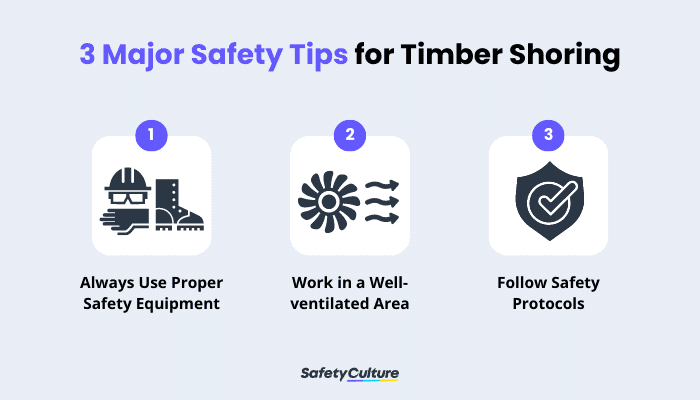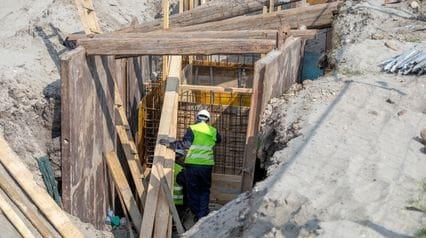What is Timber Shoring?
Timber shoring is the process of supporting a structure or soil with timbers. It is usually done to prevent the collapse of a structure or stabilize the soil. Timber shoring is often used in construction, mining, and tunneling operations and is applicable in various situations, such as accessing small areas.
There are many benefits to using timber shoring, especially during excavation. Timber is strong and durable, making it ideal for supporting a structure during construction. Timber is also less expensive than other materials, such as steel, making it a cost-effective option for projects under a tight budget.
What is the Purpose of Timber Shoring?
The purpose of timber shoring is to provide a temporary support system that is strong enough to hold up the weight of the excavation or building while the permanent support system is being put in place. It is typically used in construction and mining operations but can also work in other situations where a temporary support system is needed.
While its purpose is primarily to provide a temporary support system, timber shoring can also be used to provide a permanent support system in some cases. It is a vital part of the construction process and helps ensure excavation safety for the workers and the stability of the structure.
What are Its Components?
There are four main components of a timber shoring system, as follows:
- The vertical posts, typically made of timber or steel, support the horizontal members.
- The horizontal members are placed at intervals along the length of the excavation and are connected to the vertical posts.
- Wales are placed along the sides of the excavation to help stabilize the wall.
- Braces are placed at the corners of the excavation to help keep the excavation stable.
How Is It Installed?
Installing timber shoring is a relatively simple process, but there are a few things that must be kept in mind before proceeding:
- Make sure that the area you’re shoring up is clear of any debris.
- Inspect for any environmental or workplace hazards.
- Choose the right timber for the job. The type of timber you use will depend on the weight and type of construction materials you’re using.
Once these factors are considered, installation can now be done. Here is a simple guide for establishing a timber shoring:
- The area to be shored is excavated.
- The wood timbers are placed in the excavation and secured with metal braces.
- The soil is backfilled around the timbers to provide support.
The process of installing timber shoring is not difficult, but it does require some planning and preparation. It is also essential to have a proper understanding and knowledge of the process so that it’s done effectively and safely.
With proper installation, timber shoring can be a very effective way to shore up excavations and prevent collapse. It is also relatively inexpensive and easy to install, making it a popular choice for many construction projects.
Timber Shoring Inspections
Timber shoring inspections are conducted to ensure the system is installed correctly and in good working condition. According to the Occupational Safety and Health Administration (OSHA) standards, here are some things that must be inspected:
- All connections must be secure.
- The shoring system must be plumb and level.
- All members must be free of notches, splits, or other damage.
- Each member must be braced correctly.
- All turnbuckles, nuts, and bolts must be tightened.
- Check for any soil that has fallen away from the shoring system.
Safety Tips For Timber Shoring

3 Major Safety Tips for Timber Shoring
When working with timber shoring, there are a few safety tips to always keep in mind. By following these construction safety tips, you can help ensure that your timber shoring project goes smoothly and safely.
1. Always Use Proper Safety Equipment
Wearing Personal Protective Equipment (PPE) protects workers from accidents and injuries when working on-site. A PPE for timber shoring operations often includes gloves, eye protection, and sturdy shoes.
2. Work in a Well-ventilated Area
Make sure the area you’re working in is well-ventilated. Timber shoring can produce a lot of dust and toxic fumes that could harm the workers’ health. So it’s essential to have good ventilation to avoid breathing in too much of these harmful particles.
3. Follow Safety Protocols
Timber shoring can be dangerous if not done correctly, given the health and safety risks it poses during operations. For this reason, it’s important to follow safety protocols when working on the site. When in doubt, always check your location’s safety rules (e.g., OSHA’s guidelines) for timber shoring.
FAQs about Timber Shoring
The most common types of wood used in shoring are Douglas Fir and Southern Pine, which are both lumber softwoods. Southern Pine is stronger between the two, making it ideal for loads with known weight. However, Douglas Fir still works as a cost-effective, lightweight option for shoring.
Shoring is used in excavation to support the sides of the trench so that it does not collapse. It also provides safety and stability when excavating surfaces for construction, mining, and other purposes.
Also known as soldier piles, H or I-Beam Shoring is the most common type of shoring. It is built by putting prefabricated steel I or H sections into the ground. This type of shoring can support trenches and excavations that run from 1.2 to 5 meters in depth.
Sheeting involves using metal or wood panels to shore up the excavation walls, while shoring involves using interlocking beams to create a framework that supports the excavation walls.



